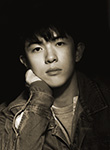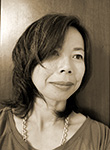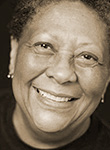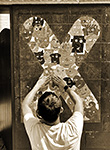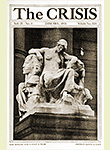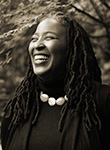All writing to a degree poses the question: “What can language do for us?” The writing that attracts us at Blackbird finds ways to address that question, a particularly urgent investigation given the times in which we are living. Blackbird v20n2 marks our fourth publication since COVID entered our lives, and we are grateful to all of the writers here for continuing to aim for communication and community across the ether.
This fall marks Blackbird’s twentieth Levis Remembered, which highlights the work of Larry Levis and recognizes Leila Chatti, winner of the twenty-fourth annual Levis Reading Prize.
Three pieces represent Levis in this issue: two poems, “To a Wren on Calvary” and “Linnets,” and the essay “Some Notes on the Gazer Within.” The essay continues to remind us that: “The moment of writing is not an escape, however; it is only an insistence, through the imagination, upon human ecstasy, and a reminder that such ecstasy remains as much a birthright in this world as misery remains a condition of it.”
The Levis work is accompanied by Gregory Donovan’s piece, “Looking Through the Wren as a Lens,” an introduction to reading Levis and to understanding certain significant Levis birds. Here also is Stephen Dunn’s short remembrance, “Larry Levis in Syracuse,” which we have republished to remind us of the importance of friendships and of how much we have lost through Dunn’s death.
Chatti’s prize-winning book, Deluge, a remarkable group of poems tackling issues of the body, the soul, and the nature of art, is represented by four poems republished from her winning collection. Three new poems, as well as a review of the book by Brandon Young, accompany the work. In “The Blood,” Chatti tells us: “I wanted to know everything about suffering / so I could avoid it. I was young enough / to think something like that.”
In Poetry, Ron Block leads us off by noting “I used to think of my country as the space / we once traveled to go see all my cousins,” but he also tells us: “Some of my cousins feel that they are trapped / outside but they are trapped inside. And when / I go home I see my country is closed.”
Alan Fang watches the backyard world to report that: “In this heat, the birds are mistiming / their migrations. Leaving too early // or too late. The old nesting places / death traps.”
torrin a. greathouse’s two poems, “Still Life in Central Valley with Fog Cannons” and “My Friend Tells Me I’ve Got to Stop Letting My Enemies Live Rent Free in My Head” explore the relationship between the body and the natural world, the inside and the outside, and the violence that exists in that space. “Sometimes, even your fingertips / could get lost in the stuff. Mist severing your arms / into mystery” and “In the sky, crossing from one state / to another, the pressure grows so bright I think the cyst might / burst” highlight such tensions. A short email conversation with greathouse appears in Features.
Anna Journey uses a nostalgic tone to connect with readers in “Experimental Perfume Class in Which I ‘Scent’ the Folkloric Witch Baba Yaga” and “My Grandparents’ Velvet Painting of The Last Supper.” Journey focuses on how innocent imagination can be typical of one’s childhood, then can carry into adulthood while exercising a lifetime of influence. The speaker says, “But I already love the tale: I can finally inhale my favorite childhood witch.”
Hints of mortality worry the edges of work by Chinese poet Song Lin, translated here by Dong Li. The poems depict the impact individuals have had in the poetic and philosophical world and traverse literary territory from Homer and Qu Yuan to Hölderlin and Nietzsche. Provocative imagery seeps through the poems, and the poet notes in “The Death of Osip Mandelstam” that “a fugitive, on the edge of an empire” is left “alone to bear a most bizarre destiny.”
Twelve poems by the late Slovenian poet Tomaž Šalamun appear in translations by Brian Henry, Šalamun’s occasional colleague and long-time friend. These non-traditional sonnets, originally published in Šalamun’s book Deception, were written in Richmond, Virginia in 2008. While these poems can seem absurd or surreal at times, they are composed with Šalamun’s profound wit and authenticity. Woven moments of quiet autobiographical allusion endow them with a rare intimacy, and his work requires readers to think with empathetic depth, as if the poems too are “people [that] rustle like a chest / waiting for an incision.”
Barbara Tran’s poems “Four Cardinals” and “Long Division” lead us through images of birds and numbers to explore the emotional weight of family relationships and carnivorous birds. In her poems, a cardinal can transport us to a view of community where “. . . we introduced / ourselves by our house / numbers 24 as if / we might be recognized / by the stairs we climb / each day the door jamb.”
Claire Wahmanholm’s poems consider absence: extinctions brought on by climate change, the loss of childhood, even her own death. Yet in cataloging these losses, the poems retain a sense of hope. In “The Future,” Wahmanholm writes, “I am mostly glad about most things, even / the future, even though I know that broken // shells may float on its waters.”
In Fiction, Deya Bhattacharya’s “Gin and Peach,” presents an affair between a hotel’s pastry chef and an opinionated millionaire. Throughout this rich, sensory story, our protagonist grapples with questions of class and identity: “[Nicole] felt nothing but a floaty displacement when she asked herself: ‘Who am I?’”
Gea Haff’s story “Wynwood Black” reconnoiters the art scene of the Wynwood neighborhood in Miami. Here murals appear as portals, “a place of many gates,” and artists are the scribes for this magic that transports a viewer through these openings. Haff offers an escape into these mural portals, “ten thousand locks with ten thousand keys.”
In “August of ’80,” Wynne Hungerford explores the rivalry between two young brothers as they witness a deadly fight between a snake and a mongoose. This story balances tenderness with the human hunger for violence: “After Charlie had thrown the last bottle . . . he told Jeff that a good fight was like good food. It satisfied something deep inside of him.”
Marilyn Nelson continues her translation from the Danish of the late Inge Pedersen’s fiction with, “Putting a Letter in the Mailbox,” the sixth installment of a previously untranslated novel. In this chapter, the narrator writes her boyfriend to end the relationship.
In Nonfiction, the seventh installment of Wesley Gibson’s memoir You Are Here continues the story of his experiences as a young gay man living in New York City at the height of the AIDS epidemic. In this section, while Gibson begins teaching in the Gotham Writer’s Workshop, he still must return to the apartment and his roommate John, whose decline progresses. Facing an immanent death, John decides to celebrate an early Christmas with his sister. Gibson notes: “That Tuesday I got home from Telesessions to find John and his sister in a sinister wonderland. Some Christmas album was playing. I don’t remember which one, but it was something heart freezing, like A Very Brady Christmas. I opened that door and reared back, like the room was a deranged motorcycle gang, headed straight for me.’
Larry Palmer’s nonfiction piece, “On Learning to Love the Sea,” details how Palmer determines the most effective way to face the racism around him—from microaggressions at a Christmas party to blatant slurs in school. Palmer writes: “I had to take a pragmatic approach in responding to racial slights and insults, varying from righteous indignation to retreat and silence.”
Blackbird editors offer micro reviews of new work by Benjamin Gucciardi, Megan Hunter, Taylor Johnson, and Arhm Choi Wild to finish the section.
In Gallery, Ashley Kistler’s multimedia essay, “Hope Wall RVA, 2020–21,” introduces the collaborative art installation launched in 2020 in Richmond’s Fan district. The creators established a public art space along a thirty-foot-long wall near Monument Avenue in response to the local Black Lives Matter protests and the ongoing COVID-19 crisis. Kistler documents the methods and motivations which led designers from twenty different countries to contribute art that explored themes of hope, grassroots activism, and the ephemeral nature of urban wheatpasting art.
Also in Gallery, another posting of historical material from the early 20th century documents selections from The Crisis, the official publication of the NAACP, that report on voter suppression, racist violence, and anti-lynching efforts in 1921.
“Paintings Within Paintings: An Informal Correspondence” presents artist Eleanor Rufty addressing aspects of her recent work as well as images of the work she discusses.
In Features, a reading by Camille T. Dungy, captured last spring as part of VCU’s Visiting Writers Series, and a conversation with artist and author Joan Gaustad round out the issue. ![]()
Return to top menus | Browse issue



